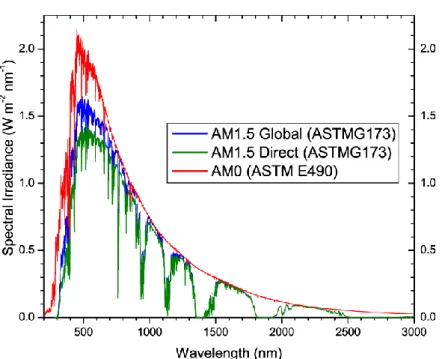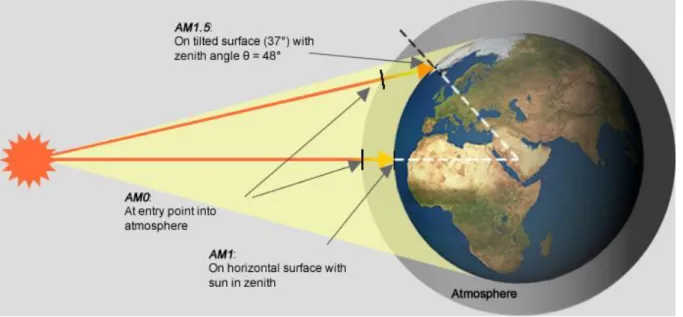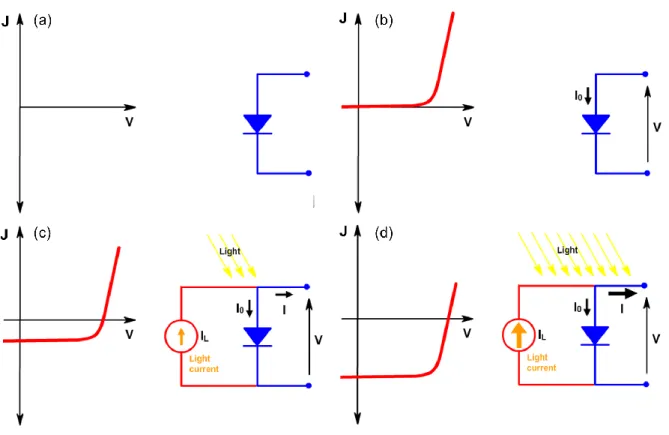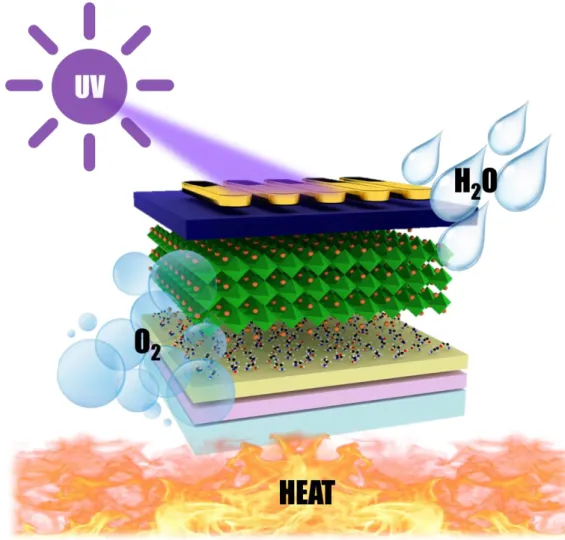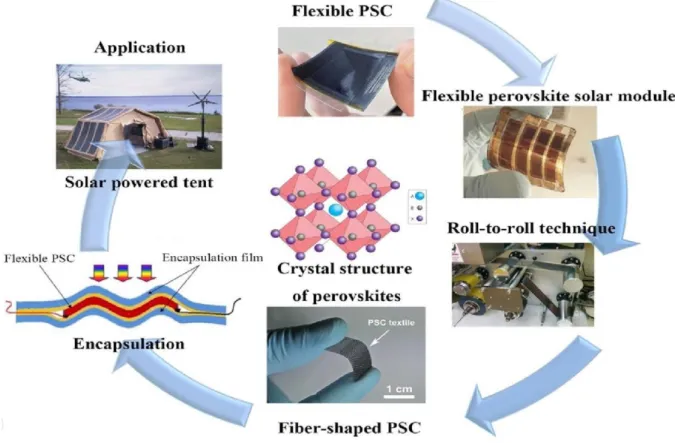While various flexible materials used for transparent electrodes and hole and electron transport layers have been introduced, irreplaceable perovskite materials have organic-inorganic crystalline structures that can be brittle. In addition to the empirical studies that determine the flexibility of the perovskite solar cells based on repeatable bending tests, studies of the mechanical properties of perovskite materials, which may be the weakest material among the constituent materials, have been carried out using nanoindentations and computational simulations. Because nanoindentations are only measured for local volume, mechanical properties measured by nanoindentations may not represent mechanical properties of film-type perovskite materials, including various defects.
The best way to overcome the limitations of nanoindentations and computational studies is to measure uniaxial tensile properties of free-standing perovskite materials, because (1) the measurement section can include all possible defects that the tensile properties represent real mechanical properties of the perovskite materials and ( 2) ) deformation and fracture behavior of the perovskite materials in any deformed state of the solar cell can be predicted by solid mechanics with their tensile properties. Designing the new mechanical test method for vulnerable perovskite materials using an in-situ nanoindentation system. Measuring direct tensile properties of organic-inorganic perovskite materials via in-situ tensile tests.
Scanning electron microscope images of crack-initiated perovskite materials after (1) 100 cycles and (2) 500 cycles with a bend radius of 0.5 mm. a) Schematics of the hole-nanoindentation experimental method, (b). Fracture stress and grain/crystal size distributions of perovskite materials obtained from previous studies and the experimental data of this study (star symbols show).
Introduction
Brief History of Perovskite Solar Cells
The basic structural component of the perovskite is the ABX3 structure, which was first discovered in the Ural Mountains by Gustav Rose in the 19th century and named after Lev Perovski who is a Russian mineralogist. When the tolerance factor, t, is about magnitude, almost inorganic elements retain the steady state in the perovskite structure. One of the widely known and early concepts was BaTiO3, this due to its unique ferroelectric properties and higher dielectric constant in the relative field [2].
After first demonstrating the promising properties of perovskite in electronics in the mid-1990s, Mitzi successfully integrated this exciting material into field-effect transistors (FETs) [5]. However, the device performance and stability were significantly reduced by the liquid electrolyte in the DSSC to dissolve the perovskite materials. To solve the problem of perovskite degradation, in 2012 Park and Grätzel achieved 9.7% efficiency by replacing the liquid electrolyte with a semiconductor hole conductor (Spiro-MeOTAD).
After using solid-state hole conductors, research on perovskite solar cells attracted much attention, and several device architectures and high-quality perovskite material fabrication methods have been proposed [7]. The excellent efficiency of such perovskite solar cells may eventually lead to the challenge of crystalline silicon solar cells.
![Figure 2.2. Best research-cell efficiencies of various solar cells. Reprinted with permission from [8]](https://thumb-ap.123doks.com/thumbv2/123dokinfo/10486840.0/24.892.114.787.454.821/figure-best-research-efficiencies-various-solar-reprinted-permission.webp)
Fundamentals of Perovskite Solar Cells
- Introduction of Perovskite Solar Cell Devices
- General Properties of Perovskite Solar Cells
- Characteristics of Perovskite Solar Cells
- Consideration of Characterization of Perovskite Solar Cells .…
- Benign Properties of Perovskite Solar Cells
- Advantages of Perovskite Solar Cells
- Limits of Perovskite Solar Cells
One of the most important factors in photovoltaic properties is the solar spectrum used to determine the performance of solar cells. The open-circuit voltage depends on the saturation current of the solar cell and the photo-generated current. Therefore, the open-circuit voltage is an index of the amount of recombination in the device.
An equivalent circuit of the solar cells with the parasitic resistance is shown in figure 2.13. The resistance effect of the solar cell reduces the PCE of PSCs by dissipating power in the resistance. Two types of solar cell quantum efficiency exist: the external quantum efficiency (EQE) and the internal quantum efficiency (IQE).
The external quantum efficiency (EQE) is the ratio between the number of charge carriers collected by the solar cell and the photon incident from outside. The internal quantum efficiency (IQE) is the ratio between the number of charge carriers collected by the solar cells and the photons absorbed by the solar cell.
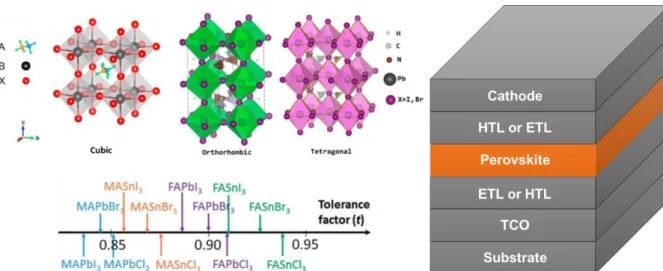
Mechanical Reliability of Perovskite Solar Cells
- Previous Studies for Mechanical Reliability
- Mechanical Testing Methods
- Computational Studies
- Flexible Perovskite Solar Cells
- Suitability of Flexible Solar Cells
- Stability of Flexible Perovskite Solar Cells
- Limits of Previous Studies in Mechanical Properties
Saliba et al., “Cesium-Containing Triple Cation Perovskite Solar Cells: Improved Stability, Reproducibility, and High Efficiency,” vol. Momblona et al., "Efficient vacuum deposited pin and nip perovskite solar cells using doped charge transport layers," vol. Marinova et al., “Organic and perovskite solar cells: working principles, materials and interfaces,” Journal of Colloid and Interface Science, vol.
Schilinsky et al., “Simulation of light intensity-dependent current characteristics of polymer solar cells,” vol. Snaith et al., “Anomalous hysteresis in perovskite solar cells,” The Journal of Physical Chemistry Letters, vol. Kim et al., “Control of I-V hysteresis in CH3NH3PbI3 perovskite solar cell,” The Journal of Physical Chemistry Letters, vol.
Song et al., "Perovskite solar cells: film formation and properties," Journal of Materials Chemistry A, vol Niu et al., "Review of recent advances in chemical stability of perovskite solar cells," Journal of Materials Chemistry A, vol .Weerasinghe et al., “Encapsulation for lifetime enhancement of flexible perovskite solar cells,” Nano Energy, vol.
Matteocci et al., “Encapsulation for long-term stability improvement of perovskite solar cells,” Nano Energy, vol. Feng et al., “Record Efficiency Stable Flexible Perovskite Solar Cell Using Effective Additive Assistant Strategy,” Advanced Materials, vol. Yang et al., “Planar-type perovskite solar cells with high efficiency and negligible hysteresis using EDTA-complexed SnO2,” Nature Communications, vol.
Kim et al., “Stable and highly efficient and bendable perovskite solar cells: toward a wearable power source,” Energy & Environmental Science, vol. Qiu et al., “Integration of perovskite solar cells into a flexible fiber,” Angewandte Chemie International Edition, vol. Li et al., “Outward migration of ions in perovskite solar cells,” Energy & Environmental Science, vol.
![Figure 2.17. Various experimental results using nanoindentation techniques. Reproduced with permission from [56-58]](https://thumb-ap.123doks.com/thumbv2/123dokinfo/10486840.0/43.892.109.789.124.661/figure-various-experimental-results-nanoindentation-techniques-reproduced-permission.webp)
Results and Discussion
Flexibility of Ultra-flexible Perovskite Solar Cells
- Introduction
- Experimental Procedure
- Materials
- Solar Cell Fabrication
- Solar Cell Characterization
- Repeatable Bending Test
- Results and Discussion
- Flexible Perovskite Solar Cells
- Repeatable Bending Tests
- Summary
- Introduction
- Experimental Procedure
- Materials
- Thin Films Fabrication
- Hole-nanoindentation Tests
- Results and Discussion
- Summary
- Introduction
- Experimental Procedure
- Materials
- Perovskite Thin Films Fabrication
- Uni-axial Tensile Tests
- Results and Discussion
- Summary
I performed repeatable bending tests using specific bending equipment, resulting in a critical bend radius of 0.5 ~ 1mm. Methylammonium iodide (MAI) purchased from Dyesol. The bottom electrode consists of a laminated structure with substrate, NOA88/PEI/Au). Normalized PCE of flexible PSCs after repeatable bending deformation with different bending cycles, bending radius of 1.0.5 mm.
Scanning electron microscopy images of crack-initiated perovskite materials after (1) 100 cycles and (2) 500 cycles with bending radius of 0.5 mm. To measure the flexibility of flexible perovskite solar cells, I have fabricated flexible PSCs using special electrode and substrate. It was confirmed by repeatable bending tests with different bending radius using specific bending apparatus.
Furthermore, this work performed repeatable bending tests on flexible PSCs with different bending radius and cycles. First 100 cycles of bending tests showed no degradation of flexible PSCs, but the smallest bending radius of 0.5 mm showed crack initiation after repeatable bending tests on perovskite materials. Besides the empirical studies that determine the flexibility of the flexible PSCs, based on repeatable bending tests, examine the mechanical properties of constituent materials on whole flexible PSCs.
I show that the critical bending radius of flexible PSCs using the elastic limit via hole-nanoindentation, resulting in some incomparable with the repeatable bending tests performed in the previous section. Hole diameters were set to be below 1%. due to the prevention of stress concentration at the edge of the hole. thin films were transferred to a substrate with a pattern of holes with diameters of 4, 8, 50 μm, as shown in Figure 4.16. a) Schematics of the mask with hole pattern, (b). Calculation of the critical bending radius based on the elastic limit measured by hole-spotting of the constituent materials in flexible PSC.
It differed from the critical bending radius measured by repeatable bending tests of 0.5 mm because the mechanical properties measured by nanoindentation of the holes are overestimated. Perovskite materials were synthesized using the same conditions and procedures as the fabrication procedures of flexible PSCs. Unlike typical polycrystalline materials, the Hall-Petch relationship reveals that the tensile mechanical properties of perovskite materials improve with increasing grain size.
Relationship between elastic limit and critical bending radius measured by hole nanoindentation and uniaxial tensile tests. It agrees well with critical bending radius of over 0.5 mm measured by repeatable bending tests as shown in Figure 4.34.
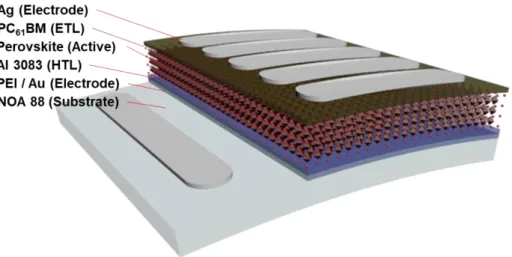
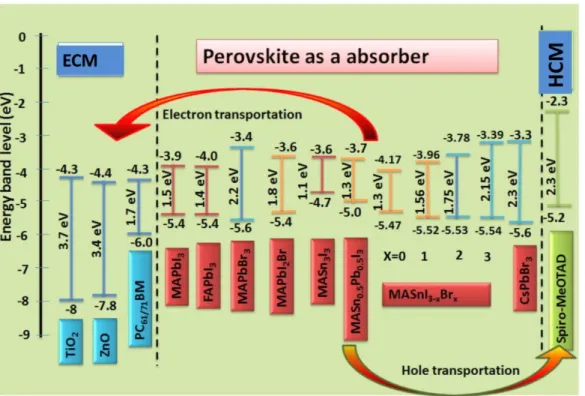
![Figure 2.7. The band alignment diagram of ETLs and HTLs used for PSCs. Reprinted with permission from [16]](https://thumb-ap.123doks.com/thumbv2/123dokinfo/10486840.0/29.892.113.783.792.998/figure-alignment-diagram-etls-htls-pscs-reprinted-permission.webp)
